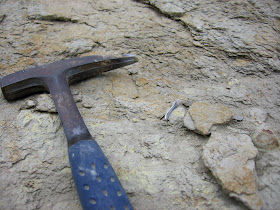Since I haven't been out in the field much down here in New Zealand during the austral winter, I've decided to occasionally post photos from past field excursions. Here, I'll show some pictures from some fieldwork last fall with Dick Hilton (Sierra College) and buddy Paul Goldsmith.

Paul (right) and I (left) investigating the face (or what's left of it) of a decomposing California Sea Lion on a long walk back from the canoes.

One of the first finds of the weekend: a proximal femur of a large (dusignathine?) walrus from the Purisima Formation, just found right on the beach.
A phocoenid (true porpoise) periotic found on the beach as well, but in a cobble. This was one of about four or five phocoenid earbones found at this locality.
Paul made a friend. This guy was just sitting there near the beach.
A nice shark tooth! A specimen of Carcharodon sp. - the serrations are fine and smaller than in extant Carcharodon carcharias, and this is instead a "transitional" specimen, transitional between Cosmopolitodus/Isurus hastalis and the modern great white. This transition has been documented elsewhere in the Purisima Formation, the Capistrano Formation of Orange County, The Pisco Formation of Peru, and (potentially) the Senhata Formation of Japan. The occurrence of these teeth is chronologically similar across the Pacific basin, and can help constrain the age of a deposit to ~7-5 Ma.
Cetacean bones galore. This little bonebed yielded a bunch of other good fossils. I don't normally collect partial vertebrae like these, although it is possible that the small vertebrae represent a partial odontocete skeleton; the large bone on the right is part of a baleen whale vertebra.
What are these bones? These two were diving into the cliff, and touching when I uncovered them. I excavated these as the tide was coming in and lapping at my backpack and other gear, and after this was wrapped in tin foil, I couldn't leave the cove by walking as the water was too deep, and had to cut hand holds into the cliff. These bones ended up being a left/right pair of mandibles from the small baleen whale Herpetocetus - they are tiny, well preserved, and probably represent a very young individual based on their 'splintery' bone texture.
Paul getting ready to ferry some fossils and tools out of the cove while the tide rises.
A huge chunk of rock we collected, with a walrus skull inside. This was my first (complete) pinniped skull, and damn was I happy to find it. Actually, I take that back; at first I was pissed, because it was in a concretion the size of a refrigerator. We found this specimen in an area with nearly no fossils, and I found it on the end of our second day in the field (out of three). We were in a remote area, and we wanted to collect it - but we had no sledge hammer, and the local hardware store closed at 4. Luckily, we saw signs for a garage sale, and although we didn't find a sledge hammer, we found an old fashioned 5 lb pipe wrench, even with a hammer head on it. Dick Hilton and I spent about twenty minutes carefully sinking chisels into the nodule with the pipe wrench, and popped off the end with the skull. We then lifted the fossil in a cargo net, lowered it into the canoe, and took the specimen out by boat. The skull is now undergoing preparation at Sierra College.
A beautiful sight on our last day of fieldwork at the locality.









I'm curious what sort of permitting process you have to go through to do this collecting. I have no expertise or interest in doing it myself, but no collecting vert. fossils is illegal w/out permit-just curious what hoops you have to jump to do so.
ReplyDeleteThis project in particular was conducted under a National Park Service paleontological collections permit. The permit application process does take a bit of effort and some patience, but in this case the six months or so of waiting really paid off. I have also received/been added on to permits before through California State Parks, and the the Humboldt North Coast Land Trust.
ReplyDelete"a National Park Service paleontological collections permit... I have also received/been added on to permits before through California State Parks, and the the Humboldt North Coast Land Trust."
ReplyDeleteyeesh that sounds like a lot. I totally get they are there to protect natural resources and make sure they go somewhere responsible (unfortunately it means i have been able to make practically no progress in my foolish endeavor. Anyway, did you ever get my email?)). Nonetheless it sounds like a very productive trip. hope you have some news on that skull in the future.
It can be a pain, certainly, but the one nice thing about having so many loops to jump through is that it keeps one from getting totally inundated by fossils and projects (and instead only being partially inundated with projects...).
ReplyDeleteNope, didn't get your email; if you sent it to my MSU email, for whatever reason, that account has decided to stop working properly. Try my gmail acct.